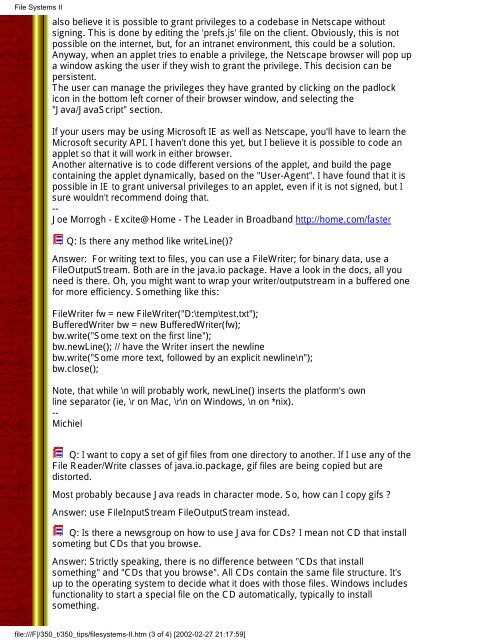You also want an ePaper? Increase the reach of your titles
YUMPU automatically turns print PDFs into web optimized ePapers that Google loves.
File Systems II<br />
also believe it is possible to grant privileges to a codebase in Netscape without<br />
signing. This is done by editing the 'prefs.js' file on the client. Obviously, this is not<br />
possible on the internet, but, for an intranet environment, this could be a solution.<br />
Anyway, when an applet tries to enable a privilege, the Netscape browser will pop up<br />
a window asking the user if they wish to grant the privilege. This decision can be<br />
persistent.<br />
The user can manage the privileges they have granted by clicking on the padlock<br />
icon in the bottom left corner of their browser window, and selecting the<br />
"<strong>Java</strong>/<strong>Java</strong>Script" section.<br />
If your users may be using Microsoft IE as well as Netscape, you'll have to learn the<br />
Microsoft security API. I haven't done this yet, but I believe it is possible to code an<br />
applet so that it will work in either browser.<br />
Another alternative is to code different versions of the applet, and build the page<br />
containing the applet dynamically, based on the "User-Agent". I have found that it is<br />
possible in IE to grant universal privileges to an applet, even if it is not signed, but I<br />
sure wouldn't recommend doing that.<br />
--<br />
Joe Morrogh - Excite@Home - The Leader in Broadband http://home.com/faster<br />
Q: Is there any method like writeLine()?<br />
Answer: For writing text to files, you can use a FileWriter; for binary data, use a<br />
FileOutputStream. Both are in the java.io package. Have a look in the docs, all you<br />
need is there. Oh, you might want to wrap your writer/outputstream in a buffered one<br />
for more efficiency. Something like this:<br />
FileWriter fw = new FileWriter("D:\temp\test.txt");<br />
BufferedWriter bw = new BufferedWriter(fw);<br />
bw.write("Some text on the first line");<br />
bw.newLine(); // have the Writer insert the newline<br />
bw.write("Some more text, followed by an explicit newline\n");<br />
bw.close();<br />
Note, that while \n will probably work, newLine() inserts the platform's own<br />
line separator (ie, \r on Mac, \r\n on Windows, \n on *nix).<br />
--<br />
Michiel<br />
Q: I want to copy a set of gif files from one directory to another. If I use any of the<br />
File Reader/Write classes of java.io.package, gif files are being copied but are<br />
distorted.<br />
Most probably because <strong>Java</strong> reads in character mode. So, how can I copy gifs ?<br />
Answer: use FileInputStream FileOutputStream instead.<br />
Q: Is there a newsgroup on how to use <strong>Java</strong> for CDs? I mean not CD that install<br />
someting but CDs that you browse.<br />
Answer: Strictly speaking, there is no difference between "CDs that install<br />
something" and "CDs that you browse". All CDs contain the same file structure. It's<br />
up to the operating system to decide what it does with those files. Windows includes<br />
functionality to start a special file on the CD automatically, typically to install<br />
something.<br />
file:///F|/350_t/350_tips/filesystems-II.htm (3 of 4) [2002-02-27 21:17:59]






